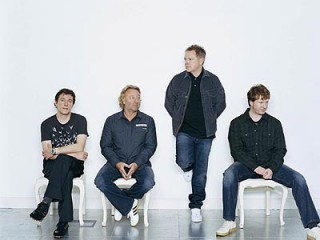
New Order biography
Date of birth : -
Date of death : -
Birthplace : Salford & Macclesfield, England
Nationality : British
Category : Arts and Entertainment
Last modified : 2010-12-10
Credited as : Alternative Pop/Rock, Post-Punk band, ,
0 votes so far
After completing sessions for Joy Division's sophomore effort, Closer, Curtis hanged himself on May 18, 1980; devastated, the remaining trio immediately disbanded, only to re-form soon after as New Order with the addition of keyboardist Gillian Gilbert. With Sumner assuming vocal duties, the new group debuted in March 1981 with the single "Ceremony," a darkly melodic effort originally composed for use by Joy Division. The LP Movement followed a few months later, and when it too mined territory similar to New Order's previous incarnation, many observers were quick to dismiss the band for reliving former glories. However, with its next single, "Everything's Gone Green," the quartet first began adorning its sound with synthesizers and sequencers, inspired by the music of Kraftwerk as well as the electro beats coming up from the New York underground; 1982's "Temptation" continued the trend, and like its predecessor was a major favorite among club-goers.
After a year-long hiatus, New Order resurfaced in 1983 with their breakthrough hit "Blue Monday"; packaged in a provocative sleeve designed to recall a computer disk, with virtually no information about the band itself -- a hallmark of their mysterious, distant image -- it perfectly married Sumner's plaintive yet cold vocals and abstract lyrics with cutting-edge drum-machine rhythms ideal for club consumption. "Blue Monday" went on to become the best-selling 12" release of all time, moving over three million copies worldwide. After releasing their brilliant 1983 sophomore album, Power, Corruption and Lies, New Order teamed with the then-unknown producer Arthur Baker to record "Confusion," another state-of-the-art dance classic, which even scraped into the American R&B charts. The group's success soon won them a stateside contract with Quincy Jones' Qwest label; however, apart from a pair of singles, "Thieves Like Us" and "Murder," they remained out of the spotlight throughout 1984.
Heralded by the superb single "The Perfect Kiss," New Order resurfaced in 1985 with Low-life, their most fully realized effort to date; breaking with long-standing tradition, it actually included photos of the individual members, suggesting an increasing proximity with their growing audience. Brotherhood followed in 1986, with the single "Bizarre Love Triangle" making significant inroads among mainstream pop audiences. A year later the group issued Substance, a much-needed collection of singles and remixes; it was New Order's American breakthrough, cracking the Top 40 on the strength of the newly recorded single "True Faith," which itself reached number 32 on the U.S. pop charts. The remixed "Blue Monday 1988" followed, and in 1989 -- inspired by the ecstasy-fueled house music that their work had clearly predated and influenced -- New Order issued Technique; their most club-focused outing to date, it launched the hits "Fine Time" and "Round and Round."
After recording the 1990 English World Cup Soccer anthem "World in Motion," New Order went on an extended hiatus to pursue solo projects; Hook formed the band Revenge, longtime companions Morris and Gilbert recorded as the Other Two, and, most notably, Sumner teamed with ex-Smiths guitarist Johnny Marr and Pet Shop Boys frontman Neil Tennant in Electronic, which scored a Top 40 hit with the single "Getting Away with It." New Order reconvened in 1993 for their biggest hit to date, Republic, which earned the band its highest charting American single ("Regret") and fell just shy of the U.S. Top Ten, despite charges from longtime fans that the band had lost its edge. A major tour followed, although rumors of escalating creative conflicts plagued the group; refusing to either confirm or deny word of a breakup, New Order simply spent the mid-'90s in a state of limbo, with Sumner eventually recording a long-awaited second Electronic LP and Hook mounting another new project, Monaco. "Brutal," the first new effort from New Order in a number of years, was featured on the soundtrack of the 2000 film The Beach, and the full-length Get Ready followed one year later. By this time, Gillian Gilbert had left the band to care for her and Stephen Morris' children, and Marion guitarist Phil Cunningham had been added to bolster the lineup. Dedicated touring followed the release of Get Ready, and New Order recorded a follow-up for release in 2005, Waiting for the Sirens' Call.
















